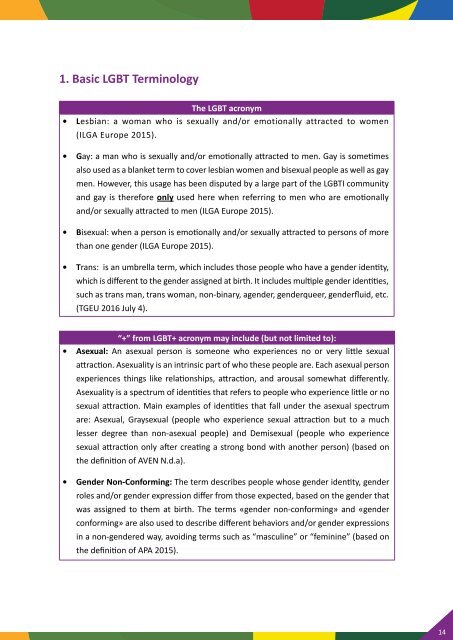Media Reporting and Reference Guide on LGBT Issues
You also want an ePaper? Increase the reach of your titles
YUMPU automatically turns print PDFs into web optimized ePapers that Google loves.
1. Basic <strong>LGBT</strong> Terminology<br />
The <strong>LGBT</strong> acr<strong>on</strong>ym<br />
• Lesbian: a woman who is sexually <str<strong>on</strong>g>and</str<strong>on</strong>g>/or emoti<strong>on</strong>ally attracted to women<br />
(ILGA Europe 2015).<br />
• Gay: a man who is sexually <str<strong>on</strong>g>and</str<strong>on</strong>g>/or emoti<strong>on</strong>ally attracted to men. Gay is sometimes<br />
also used as a blanket term to cover lesbian women <str<strong>on</strong>g>and</str<strong>on</strong>g> bisexual people as well as gay<br />
men. However, this usage has been disputed by a large part of the <strong>LGBT</strong>I community<br />
<str<strong>on</strong>g>and</str<strong>on</strong>g> gay is therefore <strong>on</strong>ly used here when referring to men who are emoti<strong>on</strong>ally<br />
<str<strong>on</strong>g>and</str<strong>on</strong>g>/or sexually attracted to men (ILGA Europe 2015).<br />
• Bisexual: when a pers<strong>on</strong> is emoti<strong>on</strong>ally <str<strong>on</strong>g>and</str<strong>on</strong>g>/or sexually attracted to pers<strong>on</strong>s of more<br />
than <strong>on</strong>e gender (ILGA Europe 2015).<br />
• Trans: is an umbrella term, which includes those people who have a gender identity,<br />
which is different to the gender assigned at birth. It includes multiple gender identities,<br />
such as trans man, trans woman, n<strong>on</strong>-binary, agender, genderqueer, genderfluid, etc.<br />
(TGEU 2016 July 4).<br />
“+” from <strong>LGBT</strong>+ acr<strong>on</strong>ym may include (but not limited to):<br />
• Asexual: An asexual pers<strong>on</strong> is some<strong>on</strong>e who experiences no or very little sexual<br />
attracti<strong>on</strong>. Asexuality is an intrinsic part of who these people are. Each asexual pers<strong>on</strong><br />
experiences things like relati<strong>on</strong>ships, attracti<strong>on</strong>, <str<strong>on</strong>g>and</str<strong>on</strong>g> arousal somewhat differently.<br />
Asexuality is a spectrum of identities that refers to people who experience little or no<br />
sexual attracti<strong>on</strong>. Main examples of identities that fall under the asexual spectrum<br />
are: Asexual, Graysexual (people who experience sexual attracti<strong>on</strong> but to a much<br />
lesser degree than n<strong>on</strong>-asexual people) <str<strong>on</strong>g>and</str<strong>on</strong>g> Demisexual (people who experience<br />
sexual attracti<strong>on</strong> <strong>on</strong>ly after creating a str<strong>on</strong>g b<strong>on</strong>d with another pers<strong>on</strong>) (based <strong>on</strong><br />
the definiti<strong>on</strong> of AVEN N.d.a).<br />
• Gender N<strong>on</strong>-C<strong>on</strong>forming: The term describes people whose gender identity, gender<br />
roles <str<strong>on</strong>g>and</str<strong>on</strong>g>/or gender expressi<strong>on</strong> differ from those expected, based <strong>on</strong> the gender that<br />
was assigned to them at birth. The terms «gender n<strong>on</strong>-c<strong>on</strong>forming» <str<strong>on</strong>g>and</str<strong>on</strong>g> «gender<br />
c<strong>on</strong>forming» are also used to describe different behaviors <str<strong>on</strong>g>and</str<strong>on</strong>g>/or gender expressi<strong>on</strong>s<br />
in a n<strong>on</strong>-gendered way, avoiding terms such as “masculine” or “feminine” (based <strong>on</strong><br />
the definiti<strong>on</strong> of APA 2015).<br />
14


